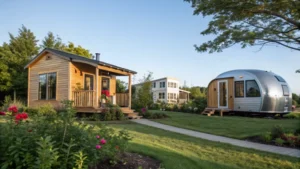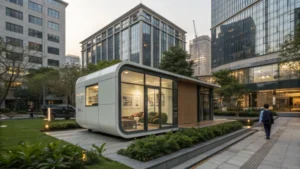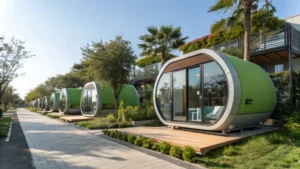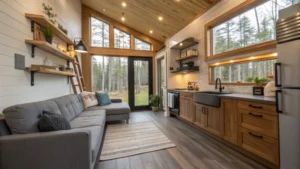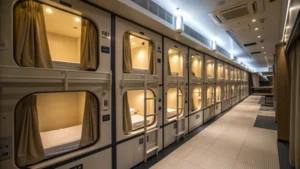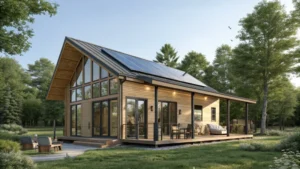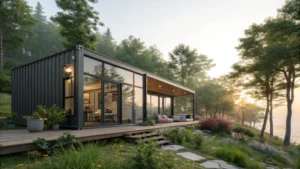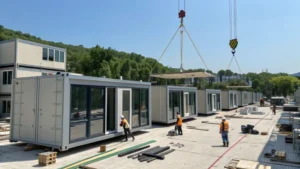
Ever wondered how long it takes to save up for a cool, eco-friendly container home?
The timeline to save for a container home depends on your monthly savings, desired features, and land costs. Saving $500 monthly could take 25 to 100 months, while saving $1,000 monthly could shorten this to 25 months for a basic setup.
I remember when I first started dreaming about building my container home. It felt like an exciting adventure, but the financial planning part seemed daunting at first. Understanding the costs involved—like the price of land and the type of finishes I wanted—helped shape my saving strategy. As I dug deeper into budgeting and explored various financing options, I realized how these steps could help me achieve my dream faster. Let me share some insights that might help you too.
Saving $1,000 monthly can fund a container home in 25 months.True
A basic container home requires 25 months of saving at $1,000/month.
Strategic saving methods don't impact container home savings timeline.False
Strategic saving can significantly shorten the time needed to save.
What Are the Costs Involved in Building a Container Home?
Embarking on the adventure of building a container home? It's not just about creativity and sustainability—getting a grip on the costs is key. Let me walk you through what you'll need to know.
Building a container home typically costs between $10,000 and $100,000 or more, influenced by design complexity, location, and land preparation. You'll also need to budget for permits, utilities, and any custom features.
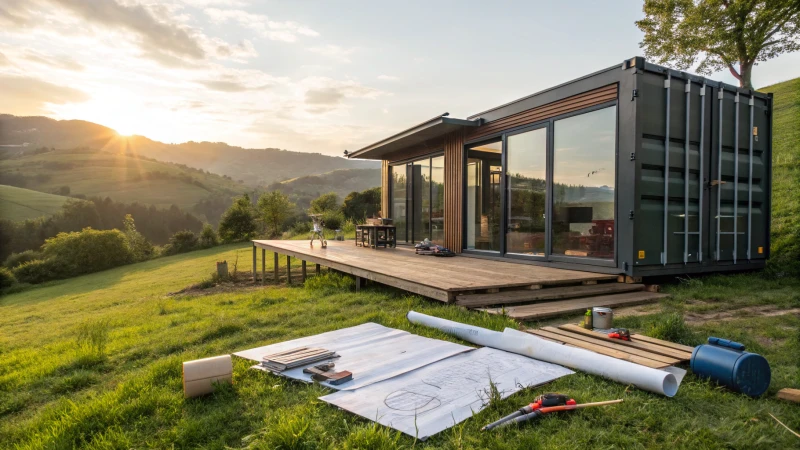
Initial Purchase Costs
I remember the thrill of picking out my first shipping container. It felt like finding a hidden treasure! Prices for these containers can vary, but generally, a basic 20-foot container will set you back between $2,000 to $5,000. If you're dreaming big and want a 40-footer, expect to pay anywhere from $3,500 to $8,000.
Design and Customization
Customizing your container home can be like piecing together a life-sized puzzle. I once spent weeks figuring out how to incorporate solar panels without blowing my budget. Here's a little breakdown of what some common features might cost:
| Feature | Estimated Cost |
|---|---|
| Basic Insulation | $1,000 - $2,500 |
| Solar Panels | $5,000 - $15,000 |
| Custom Interiors | $10,000 - $30,000 |
Land and Site Preparation
When I first started looking for land, I quickly learned how much prices could swing depending on location. Beyond just buying the land, there are costs for making it ready to build on—like clearing trees or setting up utilities. You should budget between $5,000 and $20,000 for these preparations.
Permitting and Regulations
Navigating the maze of local permits was like trying to read a map upside down. Fees can vary widely but generally fall between $500 to $2,000. Streamlining this process can save you both time and headaches. Navigating local regulations1 might be a good start.
Labor Costs
I thought about going the DIY route but realized I needed some professional help to make my dream home a reality. Hiring skilled workers can add up quickly, with general labor costs ranging from $50 to $150 per hour. However, if you're feeling brave or have some experience in construction, explore DIY options2 to keep costs down.
Financing Options
At one point, I explored every financing option under the sun to manage my budget effectively. Consider personal loans or even grants designed for eco-friendly housing projects. Learn about green loans3 as they might offer an easier way to cover upfront costs.
Maintenance and Longevity
Just like any home, your container abode will need some TLC over the years. I've found that investing in durable materials upfront can save a lot in maintenance down the line. Keep this in mind as you plan your dream space.
A 20-foot container costs between $2,000 and $5,000.True
The context states a 20-foot container ranges from $2,000 to $5,000.
Solar panels cost less than $1,000 for a container home.False
Solar panels for a container home range from $5,000 to $15,000.
How Can You Accelerate Your Savings Plan?
Saving money can feel like a marathon, but with a few smart moves, you can cross that finish line faster than you think. Let me share how I turbocharged my savings plan and how you can too.
To accelerate your savings plan, start by trimming unnecessary expenses, boost your income with side gigs, and use automation to save without thinking. Knocking out debt can also free up cash to save more.

I remember the day I realized I had to get serious about saving. It was a Sunday morning, and I was sipping coffee while scrolling through listings of container homes—my latest dream. The price tag was daunting, but the idea of living in a stylish, eco-friendly box was too appealing to ignore.
Reduce Discretionary Spending
The first thing I did was look at where my money was going. I found subscriptions I hadn’t used in months and dining out expenses that could feed a small army. By cutting these out and opting for more budget-friendly entertainment4, like cozy movie nights at home, I started saving a noticeable chunk each month.
Increase Income with Side Hustles
Next, I tapped into my skills for extra cash. I picked up some freelance gigs on Freelancer and Upwork5. It was a game-changer; just a few hours a week working on something I enjoyed made a significant difference.
Use Automation Tools
Automating savings was another step. Setting up auto-transfers from checking to savings meant I didn’t even have to think about it. Plus, apps like Acorns or Digit6 rounded up my purchases to save the spare change, which added up surprisingly fast.
Prioritize Paying Down Debt
Lastly, tackling debt was crucial. High-interest credit card balances were draining my resources. By focusing on paying these down using strategies like the snowball or avalanche7 method, I freed up more money to save.
| Strategy | Potential Benefit |
|---|---|
| Cut back on spending | More monthly cash flow for savings |
| Side hustles | Additional income stream |
| Automation tools | Ensures consistent saving habits |
| Pay down debt | Increases available cash for future savings |
Each step felt like climbing a small hill, but together they made the mountain of saving for that dream home seem less steep. With persistence and smart strategies, you can accelerate your savings plan and watch your dreams come closer into view.
Reducing discretionary spending boosts monthly savings.True
Cutting non-essential expenses increases available funds for saving.
Side hustles do not impact savings acceleration.False
Side hustles provide extra income, enhancing savings potential.
What Are the Financing Options for Container Homes?
Ever dreamed of living in a container home? You're not alone. Many are drawn to this innovative lifestyle, but how do you finance such a dream?
Yes, financing options for container homes include personal loans, specialized mortgages, and government grants. While eligibility can differ, many paths exist to help fund your eco-friendly housing vision.
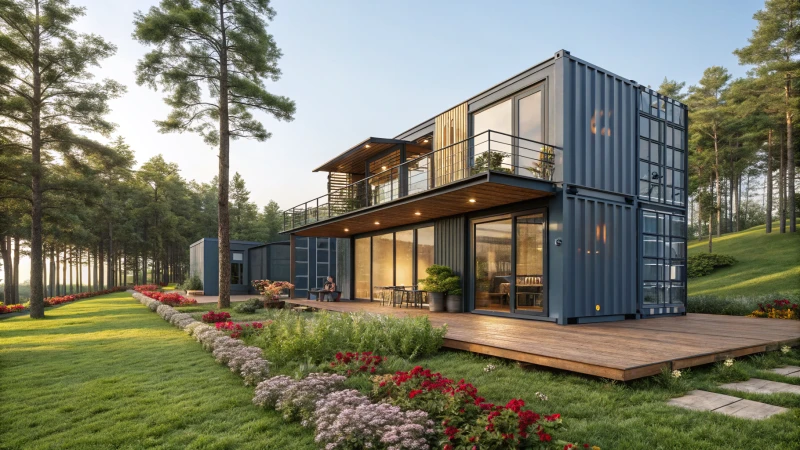
Building a container home was a dream I once thought impossible. But understanding financing options opened up a world of possibilities. Let me walk you through some of the paths that made my sustainable living dreams come true.
Personal Loans for Container Homes
I remember feeling overwhelmed by the traditional mortgage process when I first explored building a container home. That's when personal loans came into play. These loans offer flexibility and fewer restrictions, which was a breath of fresh air for someone like me, who was venturing into unconventional housing. Sure, they tend to have higher interest rates, but the quick approval process and the fact that I didn't need collateral made them a viable option.
- Pros: Fast approval, no need for collateral.
- Cons: Higher interest rates compared to traditional mortgages.
Mortgages and Specialized Loans
Traditional mortgages seemed daunting at first because container homes don't quite fit into the conventional box that banks love. However, I found solace in specialized loans. These are designed for unique housing solutions like mine and often come with terms that align better with the nature of container homes. It's worth discussing with lenders who understand and appreciate alternative housing.
| Loan Type | Interest Rates | Eligibility Criteria |
|---|---|---|
| Traditional | Lower | Good credit score, collateral |
| Specialized | Moderate | Project viability, design |
Grants and Subsidies
As I dug deeper, I was pleasantly surprised by the grants and subsidies available for eco-friendly projects. These aren't guaranteed, but if your project is sustainably sound and innovative, you might just secure some financial backing from the government. It takes some paperwork, proving the sustainability benefits, but it can significantly reduce costs.
- Availability: Regional and project-specific.
- Application: Requires evidence of sustainable practices such as using recycled materials8.
Crowdfunding Opportunities
Lastly, I turned to crowdfunding. Platforms like Kickstarter or GoFundMe allowed me to share my vision with a community of like-minded individuals who believed in sustainable living and innovative architecture. While not everyone succeeds on these platforms, they offer a unique chance to connect with people who share your passion and might even provide unexpected financial support.
Crowdfunding isn't just about money; it's about building a community around your project. This route brought together people who wanted to see my container home come to life just as much as I did through innovative architecture9.
Personal loans for container homes require collateral.False
Personal loans typically do not require collateral, offering flexibility.
Grants for container homes are available in all regions.False
Grant availability varies by region and specific project requirements.
What Should You Consider When Planning for Land and Permits?
Planning land and permits can feel like a maze, but it's essential for bringing your vision to life.
When planning for land and permits, it's crucial to consider local zoning laws, environmental assessments, utility access, and community impact. These factors ensure your project complies with regulations and runs smoothly.
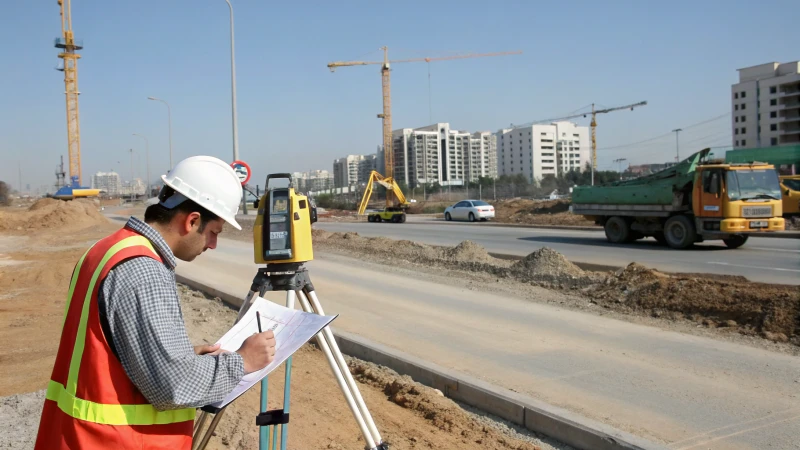
Understanding Zoning Laws
Zoning laws have a way of catching you off guard. I remember the time I thought I was all set to launch a small eco-friendly retreat, only to find out that my dream location was zoned exclusively for residential use. It was a lesson in humility—and in doing my homework. Dive into those local zoning maps and ordinances to ensure your plans are not just dreams but legally viable. For instance, residential areas10 might have restrictions on commercial development.
Environmental Assessments
Imagine standing on a piece of land, the wind in your hair, envisioning your future project. But wait—have you considered the environmental impact? I once had to reroute an entire project because I hadn’t accounted for a fragile wetland habitat. Getting an environmental assessment early on can save you from costly and heartbreaking surprises. Consider elements like water quality, wildlife habitats, and soil stability. Environmental consultants11 can offer insights into any necessary mitigation measures.
Utility Access and Infrastructure
Ah, utilities—the lifeblood of any project. I learned the hard way when my first container home lacked adequate sewage access. What was supposed to be a quick project turned into months of negotiations and extra expenses. Always evaluate access to essential services like water, electricity, and sewage before committing.
| Utility | Status | Estimated Cost |
|---|---|---|
| Water | Available | $5,000 |
| Electricity | Not Avail | $10,000 |
| Sewage | Limited | $7,000 |
Community Impact Considerations
Connecting with the local community is more than just good manners—it's smart business. Early engagement can turn potential opposition into enthusiastic support. I’ve seen projects flourish simply because the developers took the time to host public meetings and align with community values by understanding community concerns and aligning with local initiatives12.
Compliance with Local Building Codes
Ever been in the middle of a project only to hit a wall—figuratively speaking—due to code violations? I have, and trust me, it’s not fun. Ensure your blueprints are code-compliant from day one by consulting with local authorities13. It saves time and money in the long run.
Budgeting for Permit Fees
Permit fees can be sneaky little budget busters if you're not careful. I once underestimated these costs, which put a significant dent in my budget for finishing touches. Don’t make my mistake; include detailed budgeting for all potential permits:
| Permit Type | Estimated Cost |
|---|---|
| Building | $2,000 |
| Environmental | $1,500 |
| Zoning | $1,000 |
Taking the time to plan in these areas will not only keep you on the right side of the law but also help you gain community support and ensure your project’s success.
Zoning laws can restrict commercial development in residential areas.True
Zoning laws often limit commercial activities in residential zones to maintain area character.
Environmental assessments are optional for land development projects.False
Environmental assessments are typically required to identify impacts on ecosystems.
Conclusion
Saving for a container home varies based on monthly savings and desired features, with costs ranging from $10,000 to over $100,000. Smart budgeting accelerates the process.
-
This link provides guidance on understanding local building codes and regulations for container homes. ↩
-
Explore DIY tips for building a container home to save on labor costs. ↩
-
Discover financing options that offer lower rates for sustainable housing projects. ↩
-
Discover affordable entertainment options to cut unnecessary expenses and allocate more towards savings. ↩
-
Learn how to start freelancing, which can provide an additional income stream to accelerate your savings. ↩
-
Explore tools that can automate your savings, ensuring you save consistently without thinking about it. ↩
-
Find effective debt repayment strategies that can help you free up more money for your savings goals. ↩
-
Learn about government grants that support sustainable construction projects. ↩
-
Explore successful crowdfunding campaigns for unique housing projects and gather ideas. ↩
-
Understanding residential zoning laws helps determine permissible land uses, critical for avoiding legal issues. ↩
-
Environmental consultants provide expertise in identifying ecological impacts, ensuring sustainable development. ↩
-
Aligning with local initiatives promotes community support and eases project approval. ↩
-
Consulting local authorities ensures compliance with building codes, preventing costly project delays. ↩



